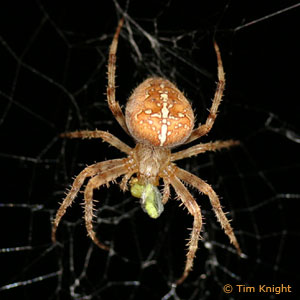

|
Cross Spider Araneus diadematus Description: The Cross Spider or Garden Spider is a very common and well-known orb-weaver spider in Western Europe. Individual spiders can range from light yellow, to orange-brown or dark grey, but all European garden spiders have mottled markings across the back with five or more large white dots forming a cross. Usually, the cross-like markings are quite visible. The mother puts eggs in a small cocoon, which looks more like a little web.
How big are they? Adult females range in length from 6.5 to 20 millimeters, and the males are 5.5 to 13 millimeters long. Range / Habitat: Introduced in the United States from Western and Northern Europe. The cross spider lives in parts of North America, in a range extending from New England and the Southeast to California and the Northwestern United States and adjacent parts of Canada. The cross spider is common in a wide range of habitats, including gardens, meadows, woodland clearings and hedgerows. It is commonly encountered next to buildings with exterior lighting. The spiders can be found in lighted stairwells of structures in rural areas. Diet: flying insects, such as, flies and mosquitoes. The cross spider spins a large complex orb-web - up to 40 cm in diameter - used to capture insect prey. The webs are built by the large females. At the tip of the abdomen there are three pairs of spinnerets, which secrete silk used to create the web. They usually face head down on the web, waiting for prey to fly by and get entangled in the sticky web. The prey is quickly captured by the female and wrapped with silk prior to being eaten (see photo below). Orb Spiders are said to eat their webs each night along with many of the small insects stuck to it. They have been observed eating the web within a couple of minutes. A new web is then spun in the morning. Reproduction: The adults are found from late summer through autumn. In late September, the females leave their webs and seek out protected locations to deposit between 300 to 900 eggs. The eggs are enclosed within a cocoon of yellow, silken threads, shaped in a hemisphere. Typical egg deposition sites include under the bark of dead trees and in cracks and crevices. (Penn State Entomology) Did you know?

Cross spider wrapping prey. Definitions:
Orbweaver - The orb-weaver spiders (family Araneidae) are the builders of spiral wheel-shaped webs often found in gardens, fields and forests. Spider - A predatory arachnid that usually has silk-spinning organs at the back end of the body; they spin silk to make cocoons for eggs or traps for prey. The word 'spider' derives from the Old English word 'spithra' and is related to the German 'spinne', both of which mean 'spinner'. Spider silk, also known as gossamer, is a protein fiber spun by spiders. Spiders use their silk to make webs, wrap prey or quickly escape predators - using the silk like a climbing rope. Learn more about spider silk More Information Cross Orbweaver Facts - Penn State University Cross Orbweaver - BugGuide.Net European garden spider - Wikipedia Checklist of Spiders of Washington USA Spider Identification Chart Photo credits: photos © Tim Knight Home | About Us | How to Participate | Biodiversity Modules | Projects | Maps | News | Resources |